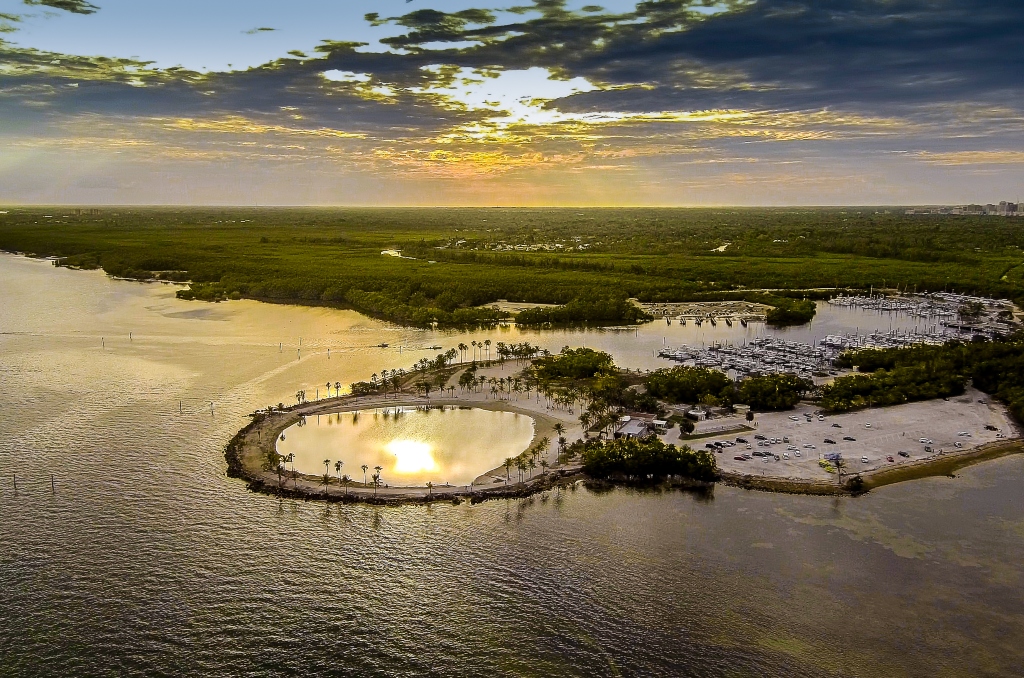Aerial view of Matheson Hammock Park in Miami, Florida, USA. Photo: Abel Santamarina/Shutterstock.com
South Floridians, may be familiar with Matheson Hammock Park, or simply “Matheson Hammock” as it is referred to by the locals, but did you know that Matheson was named after a real person? The name comes from a man named William John Matheson and he is responsible for Miami’s growth in the 20th century. Throughout the state of Florida Matheson has left his legacy behind in different ways much like Henry Flagler.
William John Matheson was born September 15, 1856, at Elkhorn, Wisconsin, a small community west of Milwaukee. He had an older brother, Hugh. His parents were Finlay Matheson of Loch Carron, Ross-shire, Scotland and his mother was Anna Meighs Lightall of Albany, New York. Finlay and Anna met while Anna was visiting her uncle, John Meigs, at Elkhorn and the two were married.
Matheson’s uncle, John (his father Finlay’s brother), was the first to move to Elkhorn, Wisconsin. Uncle John learned the tailor’s trade in Inverness, Scotland, and emigrated to the US in 1840. Uncle John worked in Milwaukee before moving to Elkhorn in 1844. He was the first merchant tailor to establish an actual business in Elkhorn and first to put out a sign. His brother Finlay followed him there soon after John had moved.
The Matheson family home was a modest two-story frame Victorian-style structure in downtown Elkhorn on the corner of Wisconsin Street and Court Street. Not much else is known about Matheson’s early life.
Sometime around 1864, the family moved to the northeast coast of South America at Georgetown, British Guyana. Finlay Matheson was to manage a huge sugar cane plantation. Sugar was the country’s principal agricultural product. In August of 1867, Finlay leased the Plantation Sans Souci from the estate of Edward Baugle for three and a half years. Apparently, he was not successful and later returned to the United States. Finlay passed away in 1882 in Toulon, Illinois.
For about two years in British Guyana William and Hugh enjoyed the strange exotic world of the jungle and year-round warm waters. Little else is known about what happened in these two years. After this time in the jungle, the family decided that William and Hugh were to be educated in Scotland.
While in Scotland. William was educated about recent breakthroughs in the development of aniline dyes. Matheson became an early importer and distributor of such dyes from Germany. He founded the National Aniline and Chemical Company, which merged with four other companies to become the Allied Chemical and Dye Corporation.
His seat on the Directorate of the General Chemical Company was the key for America to quickly enter into the manufacture of the pigments to support its involvement in the war. The General Chemical Company was an enterprise of other chemical companies that made most of the base products – the same companies that Germany had successfully prevented from competing with its products. His chemical background, patent law knowledge, industrial leadership and outstanding business acumen made William a valuable asset to the Company.
After his success in the United States, he returned to St. Andrew’s in Scotland to receive an honorary LLD degree. He set up the Matheson Scholarship and the Matheson Bursary at the university.
In 1886, one of two of Matheson’s sons Hugh Merritt Matheson was born. Hugh grew up wanting the same things his father did and when it came time to go to college, Hugh Merritt chose Yale University. Hugh chose the Adirondack School that happened to have a winter campus (Adirondack-Florida) in Coconut Grove, Florida for his high school experience.
In 1903, Headmaster Paul Ransom officially established the southern campus of the Adirondack-Florida School to include Pine Knot. It was the first migratory school in the United States. Students spent the winters in Coconut Grove and the fall and spring in the Adirondack Mountains of New York. It was renamed as Ransom School in 1949 and merged with the Everglades School for Girls in 1955, hence the present name Ransom Everglades School. Matheson’s son Hugh was one of the first students to attend.
William donated a building to the school; the Matheson Infirmary.
In 1906, William J. was instrumental in organizing the Corn Products Manufacturing Company, which became a world factor in producing corn derivatives. One of the corn derivatives was karo or corn syrup.
Matheson’s estate on Long Island, Fort Hill, was well known. He also had an estate in Coconut Grove, Florida, and created a coconut plantation on the northern two-thirds of Key Biscayne, an area now occupied by Miami-Dade County’s Crandon Park and the Village of Key Biscayne.
On May 16, 1919, William J. purchased Lignum Vitae Key in the Florida Keys from the former coconut planters, the Hine Brothers. Hine Brothers was a New Jersey Corporation of Thomas A. Hine and Charles C. Hine. William transferred Lignum Vitae Key to his son Hugh on January 30, 1929.
In 1930 William donated 80 acres to the county which was named Matheson Hammock Park. In 1940 his children donated 808 acres, the entire north end of Key Biscayne, to the county as Crandon Park and additional acreage on the other side of the bay to Matheson Hammock Park.
William Matheson passed away from a heart attack on May 15, 1930, aboard his yacht Seaforth while returning from the Bahamas. He was survived by his wife, Harriet, daughter Anna Woods and his two sons, Hugh and Malcolm.
The Executors of the Estate of Hugh M. Matheson sold Lignum Vitae Key to George Deen on March 11, 1953 for $125,000.00.
Melissa’s career in writing started more than 20 years ago. Today, she lives in South Florida with her husband and two boys.

